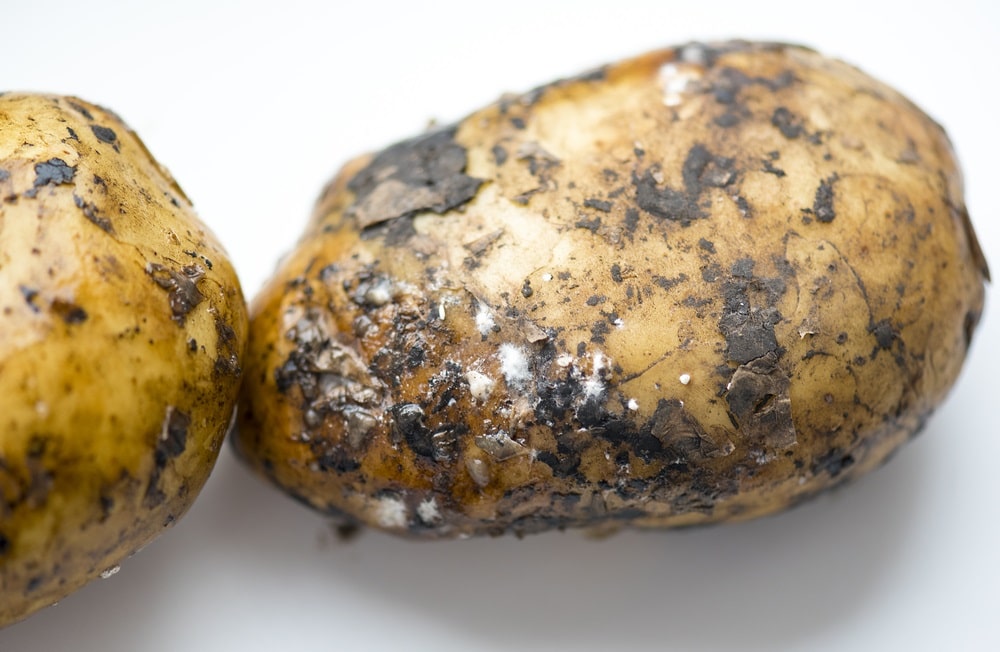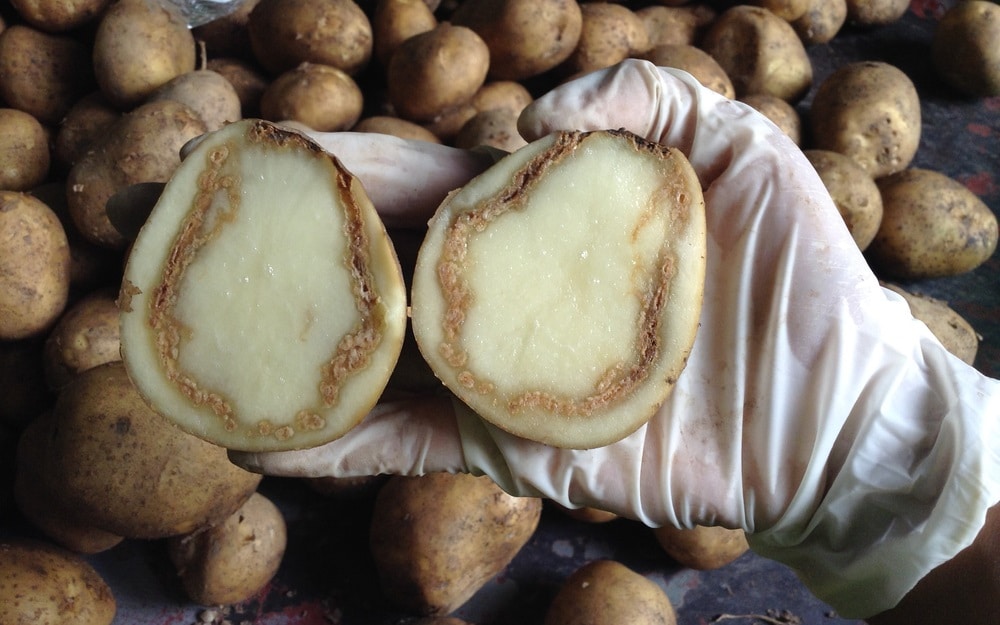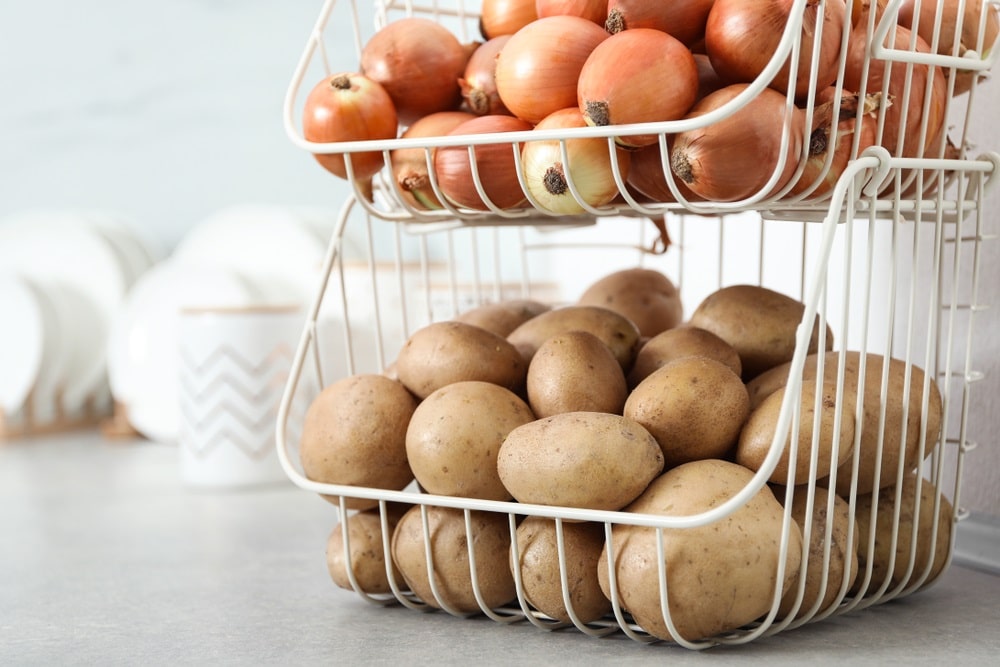
Potatoes are one of the most commonly used vegetables and have become a staple in every kitchen. One of the best things about potatoes is that they have an exceptionally long shelf life, so you can buy them in bulk and not have to worry about them going bad for a few months.
However, if you suspect there is mold on your potatoes, we are sharing everything you need to know about it!
Mold On Potatoes – What To Do?
Recognizing and Understanding Potato Mold
Mold on potatoes usually appears as a fuzzy substance on the skin, especially on bruised or damaged spots. The mold may be brownish, black, white, grey, or even reddish in color.
It is a common indicator of spoiled potatoes. Fresh potatoes tend to have an earthy aroma which signifies that the potatoes are healthy while spoiled, moldy potatoes have a very unpleasant smell.
First of all, you must understand that consuming the moldy part of potatoes is not safe because some molds are poisonous. Eating such contaminated potatoes can result in vomiting, nausea, and even food poisoning.
The only way to eat potatoes that have gone a little moldy is to cut out and discard the moldy parts and the places around them. Make sure the remaining potato is firm and wash it before cooking to remove any traces of mold.
There are different types of mold on potatoes, including solanine (green) and white mold. Solanine is a poison that leads to mold poisoning and tends to take over if the potatoes have rotted too much for a long time.
Consuming this chemical can lead to a slow pulse, headache, and abdominal pain. White mold, also called Sclerotinia stem rot, grows when conditions are damp. White mold can result in food poisoning. It’s extremely dangerous to consume this mold.
1. Texture
Potatoes should be firm to the touch and their skin should be tight. Potatoes usually become soft in storage as a result of dehydration. Discard them if they are too soft or mushy. Ideally, the potatoes must be free of black spots and large bruises.
2. Smell
Fresh potatoes have an earthy, smell like fresh soil. On the other hand, if the potatoes have an unpleasant musty smell, it indicates that they are spoiled and probably moldy.
An unpleasantly pungent smell means that the potatoes are rotten and should be put on the compost heap.
3. Sprouts
Green sprouts are a sign of imminent spoilage in potatoes. The sprouts look like little green or white growths on the potato skin. You can still eat potatoes that have started to sprout, but you should remove the green parts.
These are not mold, but a sign that the potato has started to grow. The sprouts should not be consumed because they contain chaconine and solanine, which can lead to adverse health issues, such as diarrhea and vomiting.
The Correct Way of Storing Potatoes to Prevent Mold
Freshly dug potatoes have a long (months!) shelf life if stored correctly. However, paying attention to the storage conditions can help increase their shelf life. They should be kept in a cool, dry, dark place like a cellar or pantry cupboard.
Moisture and warm temperatures can result in mold and sprouting. Exposure to light will cause them to go green. This is because of the formation of chlorophyll and also indicates that levels of glycoalkaloids (a toxin) are high.
Concentrations of this toxin are usually highest in sprouts and peel. Several reports suggest that ingesting these glycoalkaloids leads to poisoning with symptoms of gut irritation and drowsiness.
For these reasons, you should avoid storing potatoes on the counter and around the stove. Instead, the potatoes should be stored in a dry, dark, and cool place (anywhere they aren’t exposed to direct sunlight).
You may be wondering if you can store your potatoes in the fridge. After all, it is dark and cool … No, we don’t recommend you to store them in refrigerators. The fridge is a damp environment and potatoes like to be dry.
Also, storing them at too cool temperatures can cause some of their starch to convert to sugar, resulting in sweetening.
Remember to store potatoes away from other fruits and vegetables to minimize their exposure to ethylene gas. This gas, emitted by ripening fruits like bananas, can cause spoilage and sprouting in potatoes.
If you live in an extremely hot environment and need to refrigerate your potatoes, the temperature shouldn’t be less than 40 degrees Fahrenheit (4 degrees Celcius).
Always remove potatoes from their plastic packaging for storage as this will keep them damp and cause mold to grow. They are best stored either on a cold concrete floor or in a cardboard box or basket so that there is good air circulation. Try to keep them in a single layer.
Tips When Purchasing Potatoes to Prevent Mold
- If you buy potatoes from the farmer’s market that still have dirt on them, keep it on until you are ready to peel them.
- Don’t wash potatoes until you are ready to use them as this introduces moisture which mold loves.
- Always purchase the potatoes with a tight and firm texture and make sure there are no bruises and cuts as these lead to rapid rotting and mold growth.
- Don’t buy more than your family can comfortably store and eat within three months.
We hope this article has enlightened you about mold on potatoes. Stay safe and remember, “If in doubt, toss it out!”

